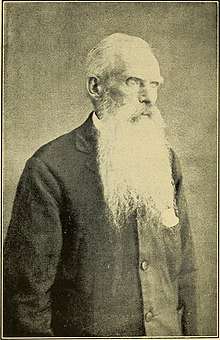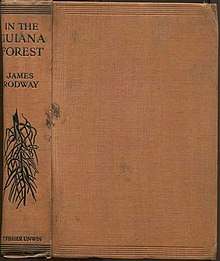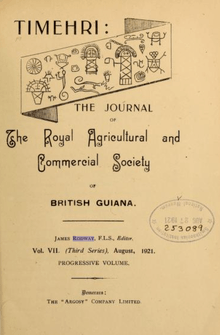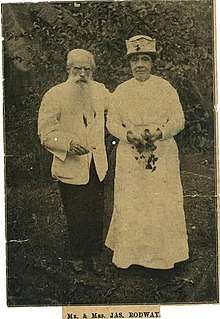James Rodway

James Rodway (February 27, 1848 – November 27, 1926)[1] was an eminent late 19th and early 20th century Guyanese historian, botanist[2] and novelist.[3] In the course of his career, Rodway helped to establish national institutions such as the Royal Agricultural & Commercial Society[4] and the British Guiana Museum. A fellow of the Linnean Society,[5] in later years he served as Editor[6] of the colony's literary and scientific journal, Timehri.
A History of British Guiana, from 1668 To The Present Time,[7] Guiana: British, Dutch and French[8] and Hand-book of British Guiana[9] are considered some of Rodway's major works.
Early life
Born 27th February 1848 in Trowbridge, Wiltshire to James and Edith Rodway (née Harding), Jabez Rodway – later to take his father's first name – was one of nine children. His father was a hawker and his mother came from a local family of weavers. Aged 13, young James began work as an apprentice with a local chemist,[10] some years later taking a position as a pharmacy assistant in Hitchin, Hertfordshire. It was from here that Rodway was to apply to a newspaper advertisement calling for clerks overseas in British Guiana, inspired by his reading on exploration and studies of the tropics – including Charles Waterton's Wanderings in South America.[11] Rodway was offered a position at Joseph Kleine & Co. and set sail aboard the R.M.S Seine on September 2, 1870, aged 22.[12]
Career
Work as a botanist
Following his arrival in the capital city of Georgetown, James Rodway – as he was now known – worked four years for Joseph Kleine & Co. before becoming manager of a pharmacy. Alongside reading the few history books available on the colony, the works of Henry G. Dalton[13] and George Hanneman Bennett,[14] in order to better acquaint himself with his new home Rodway continued to cultivate the avid interest in botany that had begun back in England as a child. He now read much of what existed on the flora and fauna of British Guiana and the Americas. Along with this came the wider personal study of insects, fish, topography and more. In any time he was able to do so, Rodway took the opportunity to walk many miles to record local plant and animal life extensively;[15] as early as 1871, he began the first of his frequent boat trips along rivers and creeks to the Guyanese interior where he would come into contact with both the native and the Boviander populations.[16] These journeys, with Rodway's detailed journaling of his discoveries and observations along their course, were to later inform much of his written works. The keen botanist steadily amassed an extensive herbarium, all the contents of which were self-described. Meanwhile, Rodway became known for his development of various orchids and ferns in the greenhouse of the Georgetown home he purchased in 1880, and won first prize at a flower exhibition held in the city's Botanical Gardens.[12]

Rodway was eventually approached by both James Thomson, Editor[17] of The Argosy newspaper and Everard im Thurn, founder and first Editor[18] of Timehri magazine – established in 1882 as the official publication of the nation's Royal Agricultural & Commercial Society. Thomson and Thurn encouraged him to put his acquired knowledge to wider use writing articles and studies for the respective institutions specific to the colony's wildlife as well its rural and Amazon-based communities. Until his death, almost no subsequent issue of Timehri would be published without one or more of Rodway's articles.[12]
By the 1890s, James Rodway was an established name in British Guiana in the field of botany. 'The Struggle for Life in the Forest' would be the article to establish Rodway in the wider world beyond the colony. Published in 1891 for Timehri and again for the Smithsonian Institution,[19] it was highly remarked upon by W.T. Stead, in the Review of Reviews.[20] That same year, on 17 December, Rodway was elected as fellow of the Linnean Society of London.[5] These developments encouraged Rodway to propose a book to the London-based publishing company T. Fisher Unwin – one that would be devised primarily from his previous botanical articles. In the Guiana Forest – Studies of Nature in Relation to the Struggle for Life was subsequently published in the year 1894.[21] With the positive reception to this book, Rodway established himself as an authority on the subject of British Guiana – in particular across the English-speaking world – even being referenced by the philosopher Herbert Spencer in his material.[22] Throughout his life, as with his historical work, Rodway's writing featured in newspapers, journals and magazines from England to Australia.
Work as a historian
In his career as colony historian, James Thomson of The Argosy was again instrumental in encouraging Rodway to hone his talent for research to deliver content for the publication. Nicholas Darnell Davis,[23][24] a colonial official of British Guiana, one-time Postmaster-General and later author, also encouraged Rodway to use his skill in archiving the nation's history. It was suggested Rodway begin this venture with an episodic series, charting British Guiana's historical development in chronological fashion. This ran in The Argosy from August 1885 through to March 1886.
Impressed by the evident dedication and detail to have gone into producing this extensive literary project, Charles Bruce – the colony's recently appointed Lieutenant Governor – enquired whether Rodway might consider compiling a catalogue from the extremely old and poorly maintained colonial documents in his office building, some dating back to the days of Dutch control over the territory. Rodway was enthusiastic and – after securing permissions from Governor Bruce to transcribe many of the documents from home – began the monumental task with the aid of a hired translator who would be able to decipher the old Hollandic dialect where necessary. The project would take months and ultimately see Rodway hand over the management of his pharmacy to his son full time.

It would be access to these files – the first comprehensive English translation of testimonies and accounts recorded by members of the colony's former Dutch administration and plantocracy – that would lead Rodway to write what would be considered the most seminal literary history of British Guiana to date.[25] 'A History of British Guiana, from 1668 To The Present Time', in three volumes (1891–1894), sought to clear up the inaccuracies of prior historians by closely comparing and referencing both Dutch and British records.
Rodway's later historical works include The West Indies and the Spanish Main (1896),[26] Guiana: British, Dutch and French (1912),[27] and The Story of Georgetown (published in 1903 and revised in 1920 – a special edition was presented to the Prince of Wales this same year on his tour visit to Georgetown).[28][29][30]
Later years
Rodway held the positions of Assistant Secretary at the Royal Commercial & Agricultural Society (1886–1888), Librarian at the Royal Commercial & Agricultural Society and Curator of British Guiana Museum (1894–1899). In addition, Rodway was Editor of Timehri well into his older years.[6][31]
50th anniversary
On 30 December 1920, James Rodway celebrated his 50th anniversary as a settler in British Guiana. He was honoured before friends and colleagues from across the country and beyond by Governor Sir Wilfred Collet at a meeting at the Royal Agricultural & Commercial Society. At the event Rodway was to be awarded an annuity of £50 – worth the equivalent of £4,341 as of 2018[32] – in recognition of his literary and scientific contribution to the colony. On this occasion, Rodway's last great work appeared in The Argosy: a revised 'The Story of Georgetown'.[15]

Personal life
James Rodway married Keturah (Kate) Johanna Reedon in Georgetown on 13 February 1873.[33] His marriage to the Guyanese born Creole may have formed the inspiration for Rodway's only published fictional work: the novel In Guiana Wilds: A Study of Two Women' (1898).[10] They went on to have 11 children, many of whom settled in England along with his wife.
References
- ↑ "The American Antiquarian Society Proceedings" (PDF). October 1929.
- ↑ Desmond, Ray (1994-02-25). Dictionary Of British And Irish Botanists And Horticulturists Including plant collectors, flower painters and garden designers. CRC Press. ISBN 9780850668438.
- ↑ Rodway, James (1899). In Guiana Wilds: A Study of Two Women. L. C. Page (incorporated).
- ↑ "The RA&CS Reading Room: That 'other' library". Stabroek News. 2014-03-23. Retrieved 2018-06-25.
- 1 2 London., Linnean Society of (1890–1893). "Proceedings of the Linnean Society of London". (1890–1893).
- 1 2 "History...TIMEHRI: Life History of the Journal of the Royal Agricultural & Commercial Society of British Guiana". Stabroek News. 2010-03-25. Retrieved 2018-06-25.
- ↑ Rodway, James (1891). History of British Guiana, from the Year 1668 to the Present Time. J. Thomson.
- ↑ Rodway, James (2018-02-19). Guiana: British, Dutch, and French. CHIZINE PUBN. ISBN 9781378060049.
- ↑ James Rodway, Royal Agricultural and Commercial Society of British Guiana Columbian Exposition Literary Committee. Hand-book of British Guiana. Harvard University. Pub. by the Committee, 1893.
- 1 2 Malchow, Howard L. (1996). Gothic Images of Race in Nineteenth-century Britain. Stanford University Press. ISBN 9780804726641.
- ↑ Charles Waterton (1839). Wanderings in South America. Oxford University. Project Gutenberg.
- 1 2 3 Dentz, Fred Oudschans (1928-01-01). "James Rodway". New West Indian Guide / Nieuwe West-Indische Gids. 9 (1): 67–77. doi:10.1163/22134360-90001336. ISSN 2213-4360.
- ↑ Dalton, Henry G. (1855). The History of British Guiana: Comprising a General Description of the Colony, a Narrative of Some of the Principal Events from the Earliest Period of Its Discovery to the Present Time, Together with an Account of Its Climate, Geology, Staple Products, and Natural History. Longman, Brown, Green, and Longmans.
- ↑ Bennett, George Hanneman (1866). An Illustrated History of British Guiana. Richardson and Company.
- 1 2 Dentz, Fred Oudschans (1928-01-01). "James Rodway" (PDF). New West Indian Guide / Nieuwe West-Indische Gids. 9 (1): 67–77. doi:10.1163/22134360-90001336. ISSN 2213-4360.
- ↑ Rodway, James (1902). "The Forest People of British Guiana". Bulletin of the American Geographical Society. 34 (3): 211–216. doi:10.2307/198325. JSTOR 198325.
- ↑ Barros, Juanita De (2003-02-19). Order and Place in a Colonial City: Patterns of Struggle and Resistance in Georgetown, British Guiana,1889–1924. McGill-Queen's Press – MQUP. ISBN 9780773524552.
- ↑ "Everard im Thurn". www.therai.org.uk. Retrieved 2018-06-25.
- ↑ "Annual report of the Board of Regents of the Smithsonian Institution. 1891". HathiTrust. Retrieved 2018-06-25.
- ↑ Shaw, Albert (1891). The Review of Reviews, Volume 04, July – December 1891.
- ↑ Rodway, James; Rodway, James; Brinsmade, Allan A. fmo; Saville, Marshall H. (Marshall Howard); Museum of the American Indian, Heye Foundation fmo; Huntington Free Library. fmo (1894). In the Guiana forest; studies of nature in relation to the struggle for life. Cornell University Library. London, T. F. Unwin.
- ↑ Spencer, Herbert (2016-11-09). The Principles of Sociology – Completed: Great Essays. VM eBooks.
- ↑ Perry, Adele (2015-04-02). Colonial Relations: The Douglas-Connolly Family and the Nineteenth-Century Imperial World. Cambridge University Press. ISBN 9781316381052.
- ↑ Higman, B. W.; Knight, Franklin W. (1999-01-01). General History of the Caribbean: Methodology and historiography of the Caribbean. UNESCO. ISBN 9789231033605.
- ↑ Higman, B. W.; Knight, Franklin W. (1999-01-01). General History of the Caribbean: Methodology and historiography of the Caribbean. UNESCO. ISBN 9789231033605.
- ↑ "West Indies and the Spanish Main, by James Rodway. – NYPL Digital Collections". digitalcollections.nypl.org. Retrieved 2018-06-26.
- ↑ Rodway, James (1912). Guiana, British, Dutch and French. Scribner's.
- ↑ Rodway, James (1920). The Story of Georgetown: Rev. from a Series of Articles in the "Argosy", 1903. "The Argosy" Company.
- ↑ Burma, Earl Louis Mountbatten Mountbatten of (1987). The Diaries of Lord Louis Mountbatten 1920–1922: Tours with the Prince of Wales. Collins. ISBN 9780002176088.
- ↑ The Prince of Wales' book; a pictorial record of the voyages of H.M.S. "Renown" 1919-1920. Robarts – University of Toronto. London [etc.] Published for St. Dunstan's by Hodder & Stoughton, Ltd. 1921.
- ↑ "community". www.indocaribbeanworld.com. Retrieved 2018-06-26.
- ↑ "£100 in 1920 → 2018 | UK Inflation Calculator". www.officialdata.org. Retrieved 2018-06-26.
- ↑ "British Guiana Colonists Index "R"". www.vc.id.au. Retrieved 2018-06-26.